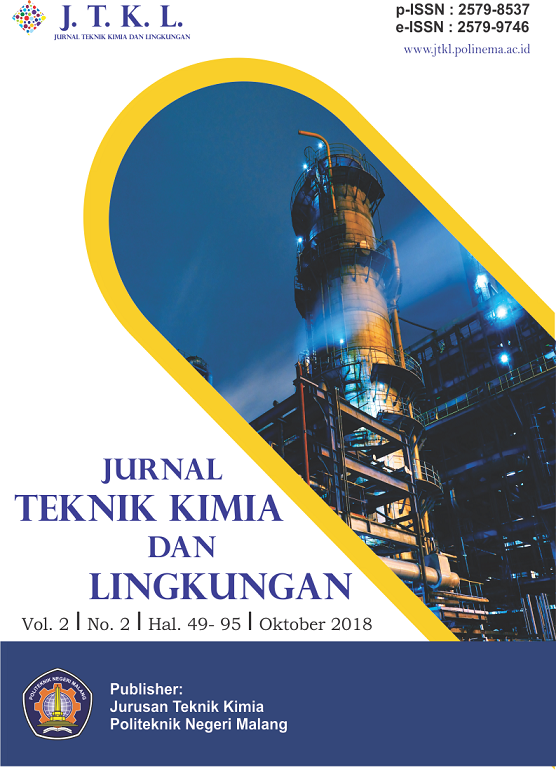Simulasi CHEMCAD: Studi Kasus Distilasi Ekstraktif pada Campuran Terner n-Propil Asetat/n-Propanol/Air
DOI:
https://doi.org/10.33795/jtkl.v2i2.75Keywords:
n-Ppropyl acetate, extractive distillation, DMSO, glycerolAbstract
Pemisahan n-propil asetat dari campuran terner n-propil asetat/n-propanol/air merupakan salah satu proses yang tidak dapat dilakukan dengan distilasi sederhana. Adanya azeotrop terner minimum dari campuran tersebut menyebabkan n-propil asetat hanya dapat dipisahkan dari campuran n-propanol dan air salah satunya dengan metode distilasi ekstraktif. Distilasi ekstraktif merupakan proses vaporisasi parsial dengan menambahkan suatu agen pemisah non-volatil yang disebut sebagai sovent atau agen ekstraktif. Solvent yang digunakan dalam simulasi proses ini adalah campuran DMSO (Dimetil Sulfoksida) dan Gliserol dengan komposisi 50 % massa dengan perbandingan 1:2 untuk massa umpan kolom : solvent. Feed yang digunakan adalah n-propanol (10 kmol/jam) dan asam asetat (13 kmol/jam) masing-masing pada suhu 25°C dan tekanan 101,3 kPa. Hasil n-propil asetat terbaik diperoleh saat solvent diumpankan pada stage 5 dengan fraksi mol n-propil asetat pada distilat 0,9975 disertai dengan minimumnya energi reboiler yang digunakan pada konfigurasi kolom ini.
n-Propyl acetate separation of the n-propyl acetate /n-propanol/water mixture composition can't be done by simple distillation. The existence of minimum ternary azeotrope on the mixture causes n-propyl acetate can be separated only by extractive distillation method. Extractive distillation is a partial vaporization process in the presence of a non-volatile separating agent called as solvent or extractive agent. Solvent used in the simulation process is DMSO (Dimethyl Sulfoxide)-Glycerol mixture (50% mass) with a ratio of 1: 2 for column feed : solvent. n-Propanol (10 kmol/hour) and acetic acid (13 kmol/hour) are fed into reactor (before extractive distillation process) at 25°C and 101.3 kPa, respectively. The best results of n-propyl acetate were obtained when the solvent was fed to stage 5 in which mole fraction of n-propyl acetate in distillate 0.9975 accompanied by the minimum reboiler energy used in this column configuration.
References
L. Berg, A.-I. Yeh, Separation of N- Propylacetate from N-Propanol by Extractive Dstillation, 4592805, 1986.
L. Berg, A.-I. Yeh, Separation of N- Propylacetate from N-Propanol and Water by Extractive Distillation, 4676874, 1987.
K. Kuswandi, W. Winarsih, D. Hartanto, A. A. Wibowo, Pengukuran Kesetimbangan Uap-Cair Sistem Biner Etanol + Etil Asetat dan Etanol + Isoamil Alkohol pada Tekanan 101,33, 79,99 dan 26,67 kPa, Prosiding Seminar Nasional Fundamental dan Aplikasi Teknik Kimia, Surabaya, 2011.
M. Brehelin, F. Forner, D. Rouzineau, J. U. Repke, X. Meyer, M. Meyer, G. Wozny, Production of n-Propyl Acetate by Reactive Distillation: Experimental and Theoretical Study, Chem. Eng. Res. Des., vol. 85, no. 1, hal. 109–117, 2007.
Z. Lei, C. Li, B. Chen, Extractive distillation: A review, Sep. Purif. Rev., vol. 32, no. 2, hal. 121–213, 2003.
F. Galli, D. Previtali, S. Casagrande, C. Pirola, F. Manenti, D. C. Boffito, Simulation of the Water-Acetic Acid Separation via Distillation Using Different Entrainers: an Economic Comparison, Chem. Eng. Trans., vol. 57, 2017.
C. Black, D. E. Ditsler, Dehydration of Aqueous Ethanol Mixtures by Extractive Distillation, Extractive and Azeotropeic Distilllation, hal. 1–15, 1974.
V. D. Dube, M. R. M. S. Bagwan, S. S. Kondawar, Simulation of Extractive Distillation Using CHEMCAD, Int. J. Sci. Eng. Res., vol. 4, no. 11, hal. 43–48, 2016.
X. Wang, Y. Yang, Simulation of Extractive Distillation for Recycling Tetrahydrofuran from Pharmaceutical Wastewater with Chem CAD Software, Res. J. Appl. Sci. Eng. Technol., vol. 5, no. 19, hal. 4769– 4774, 2013.
X. Wang, Y. Yang, Simulation of Reactive Distillation Process with ChemCAD Software, Adv. Mater. Res., vol. 347–353, hal. 3706–3709, 2011.
A. Wyczesany, Simulation Of n- Propanol Dehydration Process via Heterogeneous Azeotropic Distillation using the NRTL Equation, Chemical and Process Engineering, vol. 38, no. 1, hal. 163– 175, 2017.
I. D. Gil, L. C. García, G. Rodríguez, Simulation of Ethanol Extractive Distillation with Mixed Glycols as Separating Agent, Brazilian J. Chem. Eng., vol. 31, no. 1, hal. 259–270, 2014.
H. J. Bart, W. Kaltenbrunner, H. Landschützer, Kinetics of Esterification of Acetic Acid with Propyl Alcohol by Heterogeneous Catalysis, Int. J. Chem. Kinet., vol. 28, no. 9, hal. 649–656, 1996.
A. Chalim, A. A. Wibowo, A. S. Suryandari, M. Syarifuddin, M. Tohir, Studi Kinetika Reaksi Metanolisis Pembuatan Metil Ester Sulfonat (MES) Menggunakan Reaktor Batch Berpengaduk, J. Tek. Kim. Ling., vol. 1, no. 1, hal. 28–34, 2017.
L. Laroche, N. Bekiaris, H. W. Andersen, M. Morari, The Curious Behavior of Homogeneeous Azeotropic Distillation– Implications for Entrainer Selection, AIChE J., vol. 38, no. 9, hal. 1309–1328, 1992.
A. C. Dimian, C. S. Bildea, Chemical Process Design: Computer-Aided Case Studies, Weinheim: Wiley- VCH, 2008.
K. Samant, I. Sinclair, G. Keady, Integrated Thermal and Hydraulic Analysis of Distillation Columns, the Twenty-fourth National Industrial Energy Technology Conference, Houston, April 2002.
Downloads
Published
Issue
Section
License
Copyright (c) 2023 Agung Ari Wibowo, Cucuk Evi Lusiani, Rizqy Romadhona Ginting, Dhoni Hartanto

This work is licensed under a Creative Commons Attribution-NonCommercial 4.0 International License.







